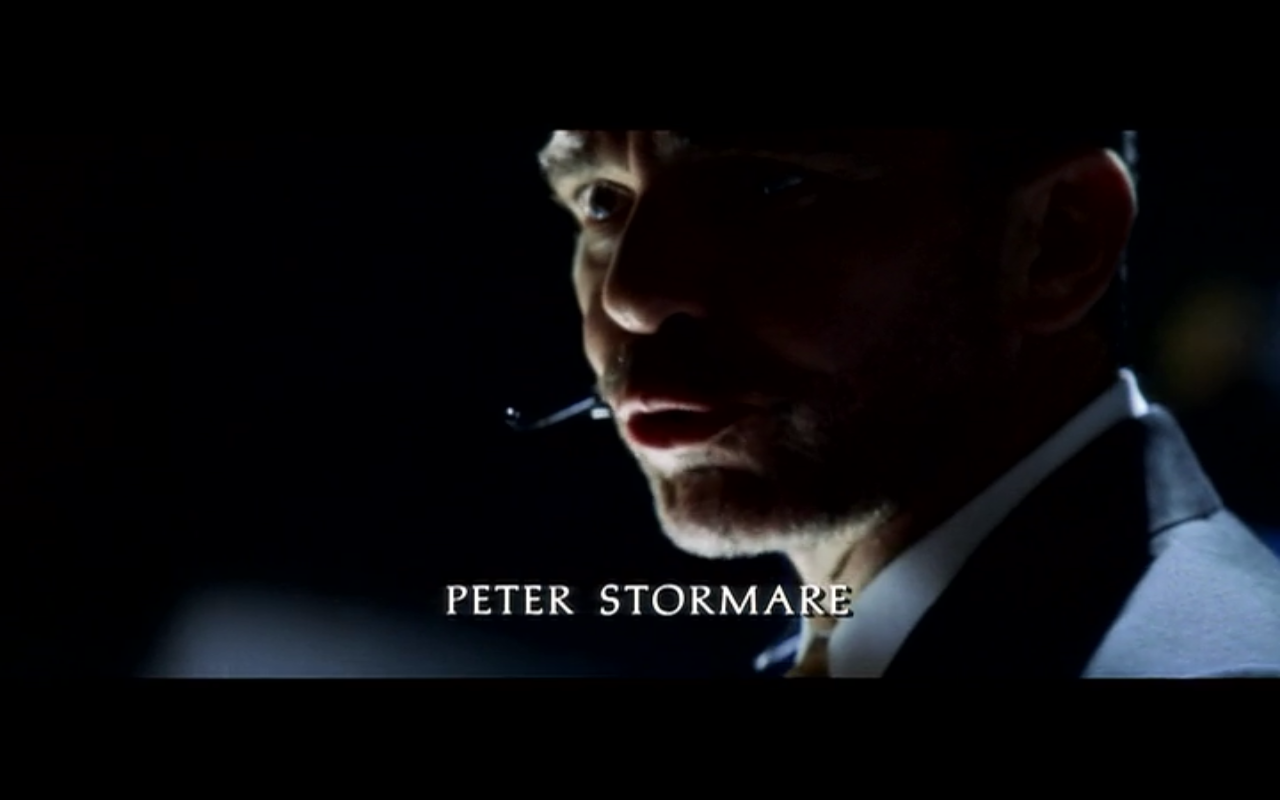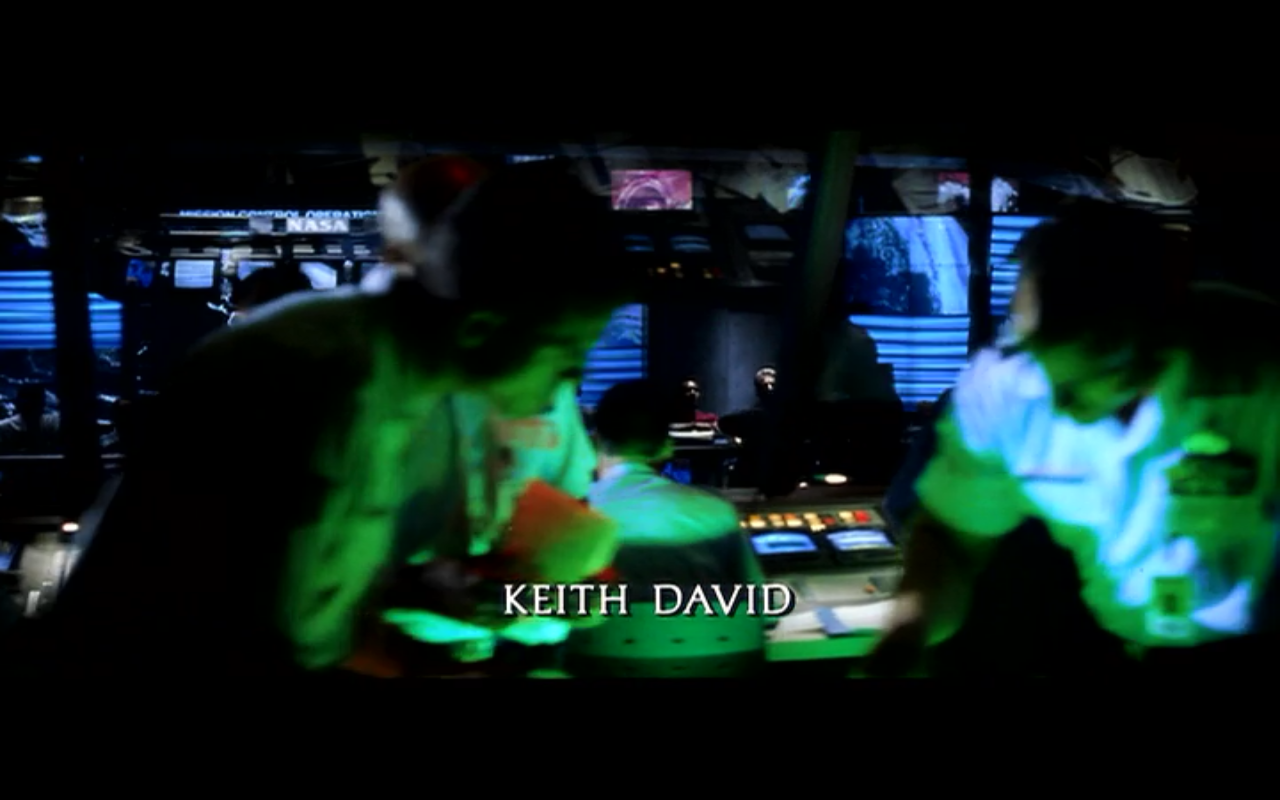So the next movie I will be analysing is Armageddon. This film is a science fiction apocalyptic hybrid.
The first few shots are of the logos of the production company, Touchstone Pictures, Jerry Bruckheimer Films and Valhalla Motion Pictures. Whilst the logos appear, string instruments begins to play as background music in a long low drone.
The next screen shots are again of the productions companie's names. The camera pans to the right and we see we are in space, an obvious element of any science fiction film. The stark contrast between the background and the text has been used in every film sequence I've analysed so far. The camera then moves through space past the moon and flutes are added to the background music. This type of music is usually heard in periodic or fantasy films, however it is very iconic of the film and instantly recognisable for anyone who has heard it before. It is very angelic and gives an almost heavenly feel, which again has been used a few times in the previous opening sequences I have already analysed.
The camera continues to pan and the audience sees the Earth along with the name of the director who has directed many science fiction film such as the Transformers franchise and I Am Number Four along with other films of the horror genre. We then hear a voice over of a man who talks of a piece of rock which wiped out life in prehistoric times. He says 'It has happened once and it will happen again', foreshadowing the event of an aesteriod on the verge of destroying the planet. As the rock hits the earth, the camera zooms in and swivels around 180° as a way of dissorienting the audience. However, it could also be used to signify that the whole world will be turned upside, literally, if the same event from prehistoric times was to happen again. As the asteroid hits, the chorus of girls who are harmonising suddenly change tempo and the music momentarily stops, immediately changing the mood from majestic to disastrous. Then a screeching sound can be heard as the man continues to talk about his disaster. Drums are added in which causes the music to speed up and the mood continually changes as the audience realises the effects of what one piece of rock can do to the world. The warning that it will happen again is more and more becoming true as the music changes to a more fast based beat.
The camera begins to pan left from the Earth to the dark, shadowed side from the previous shot and the first actors' name appears. Willis' is the first as he in the main character and is the most recognised star in the film. The camera continues to pan left as the title of the film appears and we are reavled the Earth once more, burned up and left raw as we know all life has been destroyed. The title then disappears, almost as if it has been broken down or blown apart. The music continues to build and by now, strings have been added to add to create an effective anxious mood amongst the audience. As the title appears the music builds up and slows down so all attention is on the title. The particular effect of the title on fire is an affect of what happened in the prehistoric times, however it also foreshadows the events of the film. It's only a matter of time before it is to happen again. The word Armageddon according to the Book of Revelation, the site of gathering of armies for a battle during the end times, variously interpreted as either a literal or symbolic location. The term is also used in a generic sense to refer to any end of the world scenario.
We then cut to an action scene whilst the credits are appearing on screen. There is a scene as a man in space is fixing the space station and having a discussion with those in Houston. The editing it especially good here as the camera pans from the movie title to the astronaut in space. The camera swivels when in space, simulating the anti gravity effect and the first time we see Houston, it pans across so we can see the entire place, similar to an establishing shot. The shots differ from an extreme close up to see the actions of the astronaut, to a long shot of the actual space station. This is used because we constantly cut back and forth from Houston to space, so this acts as a reminder as to where we are. There is a dialogue scene between the character on screen. The music, from the beginning of the scene, is harmonic and brings the audience back to a calm mood, leading them into a false sense of security that nothing will go wrong. However, it's not long before the astronaut in space begins to get nervous and as his fears raise, so does the speed of the string instruments, building up tension. Then, as the asteroids hit the station, a brass instrument begins to play a fast low drone, creating an erratic mood for the audience as they don't know what will happen next. A lot of enigma codes are created in this scene. Why were the fixing the station? Where did the asteroid come from? What will happen now that the station has been destroyed?
At this point, all the other names of the people appear on screen as the credits continue on from the action scene. The camera swivels from one person to another as a lot of people begin to panic about the situation that has just occurred. The music continues to build, adding to the tension now present. The camera then follows a man into the room as they tell the President of the situation and we see many people running around with a panicked nature about them - this event is clearly disastrous. The camera then pans around Billy Bob Thornton's face as he gives out order to those in Houston as the music continues to build. The camera pans as he moves through the mass of people in the room and we know he is the boss as, just like the camera, people are following him.
This idea is further confirmed as in the next shot, the camera follows him from behind, as if we re one of his workers trying to listen to his orders. The names of more co stars appear on screen as he continues to order people around. The music seems to quieten down when he talks, allowing the audience to pay their full attention to him.
There is another scene where there are no credits of a man in an observatory as he is looking through his telescope. His wife comes in and they have an argument and more credits appear on screen. At this point, no music is playing so we can hear the dialogue between the characters. In particular, the man yells at his wife to get his book which contains the numbers of NASA workers. The wife hesitates at first but then gets it as the man becomes increasingly angry, she obeys. As he yells, it echoes so the message stays with us. The event is so catastrophic that NASA is looking to anyone to help them, which also foreshadows another part of the story line.
In the next scene, the music starts again from where it left off as we see a long shot of the famous statue of soldiers in Washington DC. This signifies that idea that we are at war with nature now as an asteroid threatens humanity. There is long shot of a car being escorted by the police through Washington and in the car, here is a shot/reverse shot as two men have a conversation about what has happened in Florida. The music continues to play as string instruments create short, sharp notes, simulating a rushed paced as everyone is panicked by the event and is quickly trying to stop it.
After the dialogue scene, it cuts straightaway to a pan of New York City as Mister Big Time by Bon Jovi begins to play, immediately changing the mood with a rock song rather than tense music. This is almost contrapuntal as it doesn't quite match the mood of the movie.
The camera then follows a young black youth on his bike with his dog before it cuts to a medium shot of the dog in his basket and then to a medium close up of his face. The music then fades out at this point so we are able to hear him talk about his dream to rise to the top so he no longer has to ride his bike. He seems giddy and the song matches his mood, rather than the film's. The name of key crew members appears on screen as the dialogue is said.

The camera then changes back to a pan of the sunrise over New York and the track fades in again. Afterwards, it fades out once more as we see the youth riding his bike down the street and we hear the honk of his horn. It seems innocent and almost humorous as we watch him and his dog cycle through the city, unaware of the horrors yet to come. The credits continue to appear on screen.
In the final screen shot, the camera switches to a low angle and moves backwards as it follows the dog along the street. The music can still be heard and we continue to hear the man talking to his dog in a townie accent, making him appear common. It seems in this shot, the dog is more important than him as we follow the animal's movements rather than the youths'.
This has been the most interesting and entertaining opening sequence by far as we are straight away introduced into the film from the very beginning. I especially like how they include credits and action scenes but not at the same time. This allows the audience to engage with the film from the very beginning without getting to distracted from the text. We are still able to read it when nothing particularly interesting is happening, so we don't ignore it completely. This sequence contains a wide range of shots, camera angles and movements and has contained all the conventions of a title sequence.
There was one representation that stood out and was worth mentioning. One that has been present in a few is the fact that the male is the dominant sex. This is seen when Thornton is giving out orders to his workers and when the man is yelling at his wife, she obeys him as soon as he shows aggression.
So that's all for this analysis.
Until next time,
Toni






































No comments:
Post a Comment